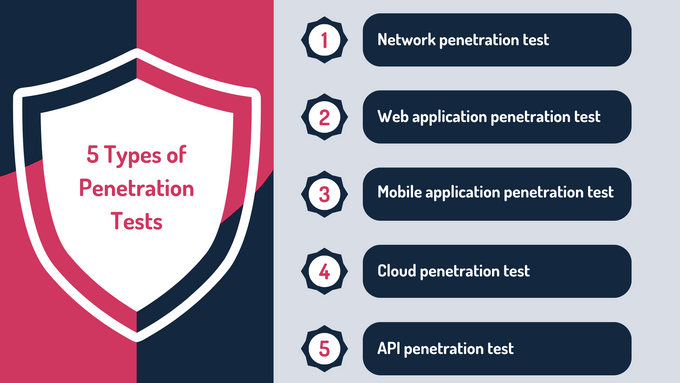Types of Penetration Testing and Their Applications in Cybersecurity
Explore the various types of penetration testing, each tailored to uncover specific vulnerabilities in systems, networks, and applications.
Published April 5, 2025.

Penetration testing (also called pentesting) has become a necessary component of a robust cybersecurity strategy. As modern cyber threats evolve, organizations must adopt proactive measures to identify vulnerabilities before malicious actors can exploit them. Penetration testing mimics real-world attack scenarios, helping businesses assess the effectiveness of their security measures and understand their risk landscape.
Understanding the specific applications and benefits of each type of penetration test can help organizations tailor their security approach to protect their systems and data.
» Let the experts handle your penetration testing needs with our startup and enterprise services
5 Types of Penetration Tests
1. Network Penetration Test
Network penetration tests focus on identifying vulnerabilities within an organization's internal and external network infrastructure.
This test simulates attacks that target firewalls, routers, and network services to uncover security gaps that attackers could exploit. Network penetration testing helps organizations fortify their network defenses, detect misconfigurations, and safeguard sensitive data against unauthorized access.
2. Web Application Penetration Test
Web application penetration tests evaluate the security of web-based applications by simulating real-world attacks.
This type of testing identifies vulnerabilities such as SQL injection, cross-site scripting (XSS), and broken authentication. Given the increasing reliance on web applications for critical business operations, these tests are essential for protecting sensitive data and maintaining user trust.
3. Mobile Application Penetration Test
Mobile application penetration tests assess the security of applications on mobile platforms, such as iOS and Android.
This type of testing identifies vulnerabilities related to data storage, insecure communications, and permissions that attackers could exploit. As mobile apps often handle sensitive user data, conducting regular penetration tests ensures that they remain secure and compliant with data protection standards.
4. Cloud Penetration Test
Cloud penetration tests examine the security posture of cloud environments, including configurations, user permissions, and data storage practices.
This type of testing is essential as businesses increasingly migrate data and applications to the cloud. By simulating these attacks, organizations can detect potential weaknesses and reinforce cloud security to prevent unauthorized access and data breaches.
5. API Penetration Test
API penetration tests focus on assessing the security of application programming interfaces (APIs), which facilitate communication between different software systems.
Due to their role in data exchange and integration, APIs are often targeted by attackers. This type of testing helps identify issues such as broken authentication, excessive data exposure, and improper error handling, enabling businesses to secure their APIs against potential exploits.
Black vs. White vs. Gray Box Testing
Black Box Testing
This simulates an attack from an external hacker with no insider information as the tester is not given any prior knowledge of the system. The tester then identifies and exploits potential vulnerabilities from a blind starting point, simulating a real external attack.
White Box Testing
This type of testing allows for a thorough examination of the system by providing the tester with full access to the internal documentation, source code, and architecture of the system.
Gray Box Testing
Gray box testing is a hybrid approach where the tester has some knowledge of the system, such as access credentials, but not full access like in white box testing. This method is commonly used to test web applications and other systems where the tester needs to understand some internal workings to effectively test for vulnerabilities.
» Need more info? Understand the different kinds of penetrations tests
Applications of Penetration Testing in Various Industries
Penetration testing serves as a critical tool across multiple industries, each with unique security challenges and regulatory requirements. Its adaptability and comprehensive approach make it an essential component of modern cybersecurity strategies, tailored to meet the needs of diverse sectors.
| Industry | Purpose of Penetration Testing | Key Benefits and Focus | Compliance & Security Standards |
|---|---|---|---|
| Finance | Identify vulnerabilities in networks, applications, and databases to secure sensitive customer data and financial transactions. | Enhances client and partner trust by reducing risks of financial fraud, data breaches, and unauthorized access. | Ensures compliance with regulations like PCI DSS. |
| Healthcare | Securing electronic health records (EHRs) and connected medical devices by identifying potential vulnerabilities that could be exploited in real-world attacks. | Protects patient data and ensures the integrity of medical devices, preventing potential data breaches and disruptions in patient care. | Helps healthcare providers comply with HIPAA and similar laws. |
| Government and Defense | Assessing the security of networks, databases, and communication systems to prevent breaches that may compromise national security. | Enhances defense against nation-state actors and cybercriminals, supporting government bodies in meeting cybersecurity mandates. | Aligns with national cybersecurity mandates and regulations. |
» Boost your security strategy with PCI DSS compliance and thorough penetration testing
Challenges and Limitations of Penetration Testing
- Point-in-time assessment: Penetration tests provide a snapshot of the security posture at the time of testing. They can identify existing vulnerabilities, but may not account for new vulnerabilities that arise after the test or for system changes, such as updates or new integrations.
- Limited scope: The scope of a penetration test may be limited to certain assets or networks, potentially leaving untested areas vulnerable if not included in the assessment plan.
- Reliance on human expertise: Penetration testing is inherently manual and relies heavily on the tester’s skills and experience, which can lead to variable results.
- Potential for system disruptions: Although precautions are taken, penetration testing involves simulating real-world attacks, which can carry a small risk of causing system instability or disruptions.
Unlike automated vulnerability scans, penetration tests require skilled professionals to conduct thorough evaluations, making them more resource-intensive and potentially costly.
» Here are the disasters you can avoid by tackling cybersecurity on time
Complementary Strategies for Comprehensive Cybersecurity
Regular Vulnerability Scans
- Identifies and mitigates potential weaknesses across digital infrastructure.
- Automated, offering continuous monitoring and real-time insights into emerging security gaps.
- Provides consistent updates, in contrast to the less frequent, manual penetration tests.
» Unsure about the differences? Compare penetration testing to vulnerability scanning
Firewall Implementation
- Monitors and controls network traffic based on predefined security rules.
- Serves as a frontline defense to prevent unauthorized access.
- Enhances protection by blocking potential threats before they reach critical systems.
Research and Development (R&D)
R&D helps organizations stay informed about evolving cybersecurity threats and develop proactive measures tailored to new risks. Planning ahead ensures that security measures are in place before threats arise, reducing the need for reactive responses.
Additionally, implementing application security practices throughout the development lifecycle builds secure applications from the ground up, strengthening the overall security framework and making it more resilient to cyber threats.
Combining penetration testing with continuous vulnerability scanning, robust firewalls, proactive research, and secure development practices ensures a comprehensive and adaptable cybersecurity strategy.
» Learn more: The importance of penetration testing
Future Trends in Penetration Testing
Future trends in penetration testing are shaped by the evolving landscape of cyber threats and the need for more advanced defensive measures.
- Automation and AI-driven tools: These tools are becoming increasingly integrated into penetration testing, enabling faster vulnerability identification and more sophisticated cyberattack simulation.
- Continuous penetration testing: This approach allows organizations to maintain an up-to-date understanding of their security posture and address vulnerabilities as they emerge.
- Specialized tests for emerging technologies: These technologies focus on IoT devices, blockchain applications, and cloud-native environments and are expected to become more prominent as businesses expand their digital footprints.
» Keep your business protected by learning about the CIA triad in cybersecurity
Make GRSee Your Penetration Testing Partner
GRSee stands out as a trusted partner for businesses seeking comprehensive penetration testing services. Our approach begins with an in-depth scoping session tailored to your organization's unique needs and security challenges. Unlike generic solutions, our penetration tests dive into business logic and workflows, identifying vulnerabilities that conventional tests may overlook and securing critical processes specific to your business.
» Contact us to learn how penetration testing can elevate your security






